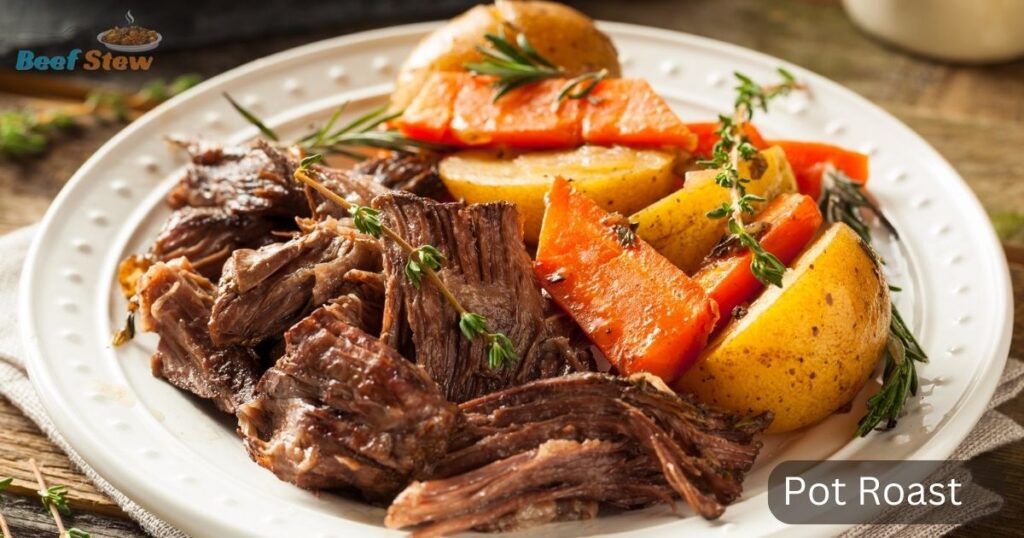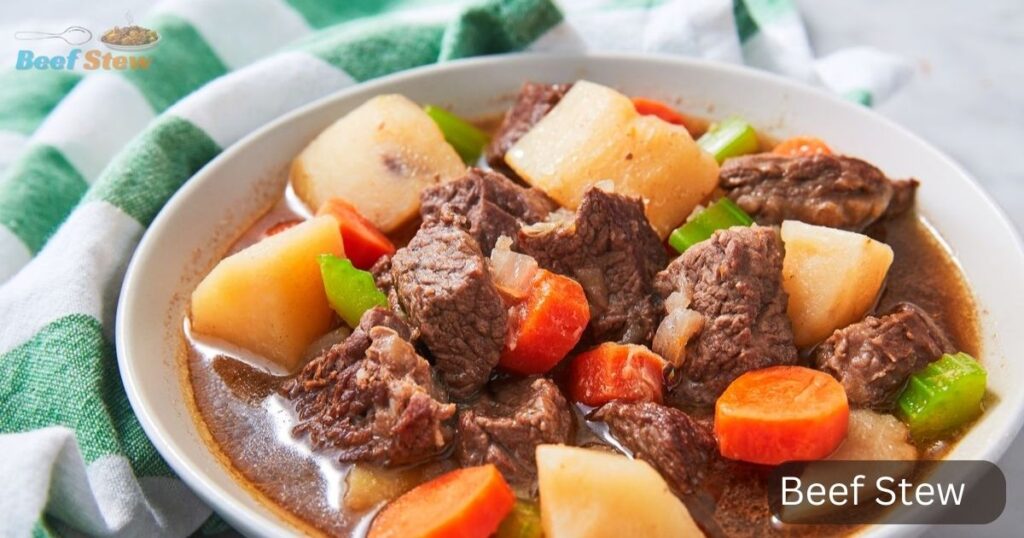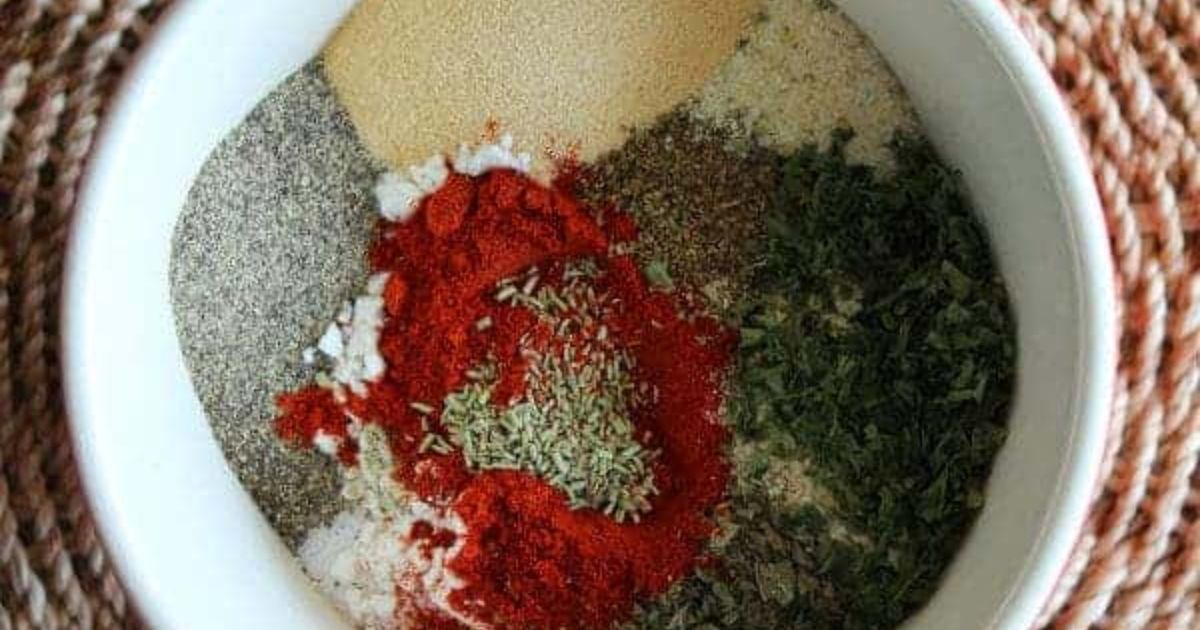While beef stew seasoning and pot roast seasoning share some common ingredients like garlic, onion, thyme, and bay leaves, they may also have variations that cater to the specific flavors of each dish.
If you’re in a pinch, you can certainly use beef stew seasoning for pot roast, but keep in mind that the flavor profile might not be exactly the same as traditional pot roast seasoning. Pot roast seasoning typically emphasizes deeper, richer flavors to complement the slow-cooked meat, while beef stew seasoning might be a bit lighter and more herb-forward.
To compensate for any flavor differences, you can adjust the seasoning blend by adding more of certain herbs or spices commonly found in pot roast seasoning, such as rosemary, parsley, or even a touch of Worcestershire sauce for depth. Taste as you go and adjust according to your preference.
Ultimately, while it might not be an exact match, using beef stew seasoning for pot roast can still yield a delicious result with a slightly different flavor profile.
Can I Use Beef Stew Seasoning for Pot Roast?
Yes, you can use beef stew seasoning for pot roast, but adjust quantities for personal taste preferences.
What is the Difference between Pot Roast and Beef Stew?
Pot roast and beef stew are both classic comfort dishes made with beef, but they differ in terms of cooking method, texture, and presentation.
Cooking Method:
Pot roast is typically cooked by searing a large cut of beef (such as chuck roast) and then slow-cooking it in liquid (often broth or wine) until it becomes tender. It’s usually cooked in a covered pot or Dutch oven in the oven or on the stovetop.
Beef stew, on the other hand, involves cutting the beef into smaller, bite-sized pieces and cooking it with vegetables (such as carrots, potatoes, and onions) in a flavorful broth or sauce. It’s usually cooked in a pot on the stovetop or in a slow cooker.
2. Texture:
Pot roast tends to have a tender, falling-apart texture due to the slow cooking process, while still retaining some meatiness.
Beef stew has a thicker, stew-like consistency with tender chunks of beef and vegetables in a rich broth.
3. Flavor:
Pot roast often has a rich, savory flavor with undertones of the beef’s natural juices and the seasonings used during cooking.
Beef stew is typically more robust in flavor, as it incorporates various vegetables and herbs into the cooking liquid, resulting in a hearty and well-rounded taste.
4. Presentation:
Pot roast is usually served as slices of meat with vegetables and gravy on the side or poured over the top.
Beef stew is served as a complete dish, with the beef and vegetables in the flavorful broth served together in a bowl.
While both dishes feature beef as the main ingredient and are often enjoyed during colder months for their warmth and heartiness, they offer different culinary experiences due to their distinct cooking methods, textures, and flavors.
What is Pot Roast?

Pot roast is a comforting dish consisting of tough cuts of beef, like chuck roast, slow-cooked in liquid until tender. Typically seared and then simmered with aromatic vegetables and seasonings, it yields moist, flavorful meat infused with savory juices. Served alongside mashed potatoes or roasted vegetables, pot roast is a beloved comfort food staple, perfect for chilly days and family gatherings.
How Do You Make Pot Roast?
To make pot roast, follow these basic steps:
- Choose the Meat: Select a tough cut of beef suitable for slow cooking, such as chuck roast or brisket. Aim for a piece with some marbling, as this will add flavor and tenderness.
- Season and Sear: Season the meat generously with salt and pepper, and any other desired herbs or spices. Heat oil in a large pot or Dutch oven over medium-high heat and sear the meat on all sides until browned. This step helps develop flavor and texture.
- Add Aromatics and Liquid: Remove the meat from the pot and set aside. Add aromatic vegetables like onions, carrots, and celery to the pot and cook until softened. Then, deglaze the pot with liquid such as beef broth, red wine, or a combination of both, scraping up any browned bits from the bottom of the pot for added flavor.
- Cook Slowly: Return the seared meat to the pot, along with any accumulated juices. Add additional seasonings like garlic, thyme, and bay leaves for flavor. Cover the pot and reduce the heat to low. Simmer the pot roast gently for several hours, until the meat is tender and easily shreds with a fork.
- Add Vegetables (Optional): If desired, add hearty vegetables like potatoes, carrots, and mushrooms to the pot during the last hour of cooking. This allows them to absorb the flavors of the cooking liquid and become tender.
- Serve: Once the meat is tender and the vegetables are cooked through, remove the pot roast from the heat. Slice or shred the meat and serve it with the vegetables and cooking liquid as gravy. Garnish with fresh herbs, if desired, and enjoy!
Adjust the seasonings and cooking time according to your preferences and the size of the meat. Pot roast is a forgiving dish that can be customized to suit your taste, making it a versatile and comforting meal option.
What is Beef Stew?

Beef stew is a comforting dish made with chunks of beef simmered with vegetables in a flavorful broth or sauce, perfect for colder weather and enjoyed as a main course.
How Do You Make Beef Stew?
To make beef stew, follow these basic steps:
- Prepare the Beef: Cut beef into bite-sized chunks and season with salt and pepper. Optionally, coat the beef in flour to help thicken the stew.
- Brown the Beef: Heat oil in a large pot or Dutch oven over medium-high heat. Brown the beef in batches to ensure even cooking. Remove and set aside.
- Sauté Aromatics: In the same pot, add diced onions, carrots, and celery. Cook until softened, about 5 minutes. Add minced garlic and cook for another minute.
- Deglaze the Pot: Pour in a liquid like beef broth, red wine, or a combination of both to deglaze the pot, scraping up any browned bits from the bottom for added flavor.
- Combine Ingredients: Return the browned beef to the pot. Add chopped potatoes, thyme, bay leaves, and any other desired seasonings.
- Simmer: Bring the stew to a simmer, then reduce the heat to low. Cover and cook for about 1.5 to 2 hours, or until the beef is tender and the vegetables are cooked through.
- Thicken (Optional): If desired, thicken the stew by creating a slurry with equal parts flour and cold water. Stir the slurry into the stew and simmer for a few minutes until thickened.
- Adjust Seasoning and Serve: Taste the stew and adjust seasoning as needed with salt and pepper. Remove bay leaves before serving. Garnish with chopped parsley if desired and serve hot.
Enjoy your homemade beef stew with crusty bread or over mashed potatoes for a comforting and delicious meal!
Can You Use the Same Seasoning for Beef Stew and Pot Roast?
Yes, you can use the same seasoning for both beef stew and pot roast, but you may need to adjust quantities based on personal preference and desired flavor profiles.
Beef Stew and Pot Roast Seasoning Ideas
For both beef stew and pot roast, here are some seasoning ideas to enhance flavor:
1. Garlic: Fresh minced garlic or garlic powder adds depth of flavor.
2. Onion: Finely chopped onion or onion powder for savory sweetness.
3. Thyme: Dried or fresh thyme leaves lend earthy aroma and flavor.
4. Rosemary: Fresh or dried rosemary adds a robust, pine-like flavor.
5. Bay Leaves: Whole bay leaves for subtle herbal notes.
6. Salt and Pepper: Essential for seasoning the meat and vegetables.
7. Paprika: Smoked or sweet paprika for a hint of warmth and color.
8. Worcestershire Sauce: Adds umami depth and richness.
9. Beef Broth: Use as a base for both seasoning and cooking liquid.
10. Red Wine: Adds complexity and depth to the flavor profile (especially for pot roast).
11. Tomato Paste: Enhances richness and depth of flavor.
12. Celery Seed: Ground celery seed for a subtle celery flavor.
13. Brown Sugar: A touch of sweetness to balance savory flavors.
14. Dijon Mustard: Adds tanginess and depth to the sauce.
15. Herb Bouquet Garni: Bundled herbs like parsley, thyme, and bay leaf for easy removal after cooking.
Adjust the amounts of each seasoning based on personal preference and taste. Experiment with combinations to find the perfect blend for your beef stew or pot roast.
Beef Stew Seasoning
Beef stew seasoning is a flavorful blend of herbs and spices used to enhance the taste of beef stew.
What Do You Need?
| Seasoning Ingredient | Quantity |
| Garlic powder | 2 teaspoons |
| Onion powder | 2 teaspoons |
| Dried thyme | 1 teaspoon |
| Dried rosemary | 1 teaspoon |
| Bay leaves | 2 leaves |
| Paprika | 1 teaspoon |
| Salt | To taste |
| Pepper | To taste |
Adjust the quantities according to your taste preferences, and enjoy the flavorful beef stew!
How to Prepare
To prepare the beef stew seasoning:
1. Combine Ingredients: In a small bowl, mix together the garlic powder, onion powder, dried thyme, dried rosemary, paprika, salt, and pepper.
2. Crush Bay Leaves: Using your fingers or a mortar and pestle, crush the bay leaves into smaller pieces before adding them to the seasoning mix. This helps release their flavor.
3. Mix Well: Stir all the ingredients together until well combined. Ensure that the seasonings are evenly distributed throughout the mixture.
4. Store: Transfer the seasoning blend to an airtight container or spice jar for storage. Keep it in a cool, dry place away from direct sunlight.
Your beef stew seasoning is now ready to use! Simply sprinkle it over your beef stew ingredients before cooking to add delicious flavor to your dish. Adjust the seasoning amount to suit your taste preferences. Enjoy your flavorful beef stew!
How to Use Beef Stew Seasoning for Pot Roast?
To use beef stew seasoning for pot roast, simply rub the seasoning blend onto the beef roast before searing it. Then, follow the usual steps for pot roast, including searing the meat, adding aromatics and liquid, and simmering until tender. Adjust seasoning to taste and enjoy your flavorful pot roast!
Is beef stew seasoning the same as pot roast seasoning?
Beef stew seasoning and pot roast seasoning may share some common ingredients like garlic, onion, thyme, and bay leaves, but they can have variations tailored to the specific flavors of each dish, making them not exactly the same.
Can I Use Beef Stew Seasoning for Pot Roast
Is stew meat the same as pot roast?
Stew meat consists of small pieces of beef used in stews, while pot roast refers to a large cut of beef cooked whole in a pot until tender.
What can I add to pot roast for more flavor?
| Ingredient | Description |
| Onions, garlic | Provide depth of flavor to the dish. |
| Thyme, rosemary | Add savory aroma and complexity. |
| Tomato paste | Enhances richness and depth in the sauce. |
| Worcestershire sauce | Adds umami depth and complexity. |
| Beef broth or stock | Contributes richness to the cooking liquid. |
| Red wine | Adds complexity and depth of flavor. |
| Dijon mustard | Imparts tanginess and depth to the sauce. |
| Mushrooms | Provide earthy flavor and add texture. |
What makes pot roast taste good?
| Factor | Description |
| Choice of Meat | Well-marbled cuts like chuck roast ensure rich flavor and tenderness. |
| Searing | Browning the meat before slow cooking adds depth and flavor. |
| Aromatics | Onions, garlic, carrots, and celery provide a flavorful base. |
| Herbs and Spices | Thyme, rosemary, bay leaves, and others add aromatic complexity. |
| Liquid | Beef broth, red wine, or a combination infuse the meat with flavor. |
| Cooking Method | Slow cooking at low heat allows flavors to meld and meat to become tender. |
| Time | Simmering for several hours develops rich flavors and texture. |
| Seasoning | Balancing salt, pepper, and other seasonings enhances the flavor profile. |
FAQ
Is beef stew seasoning the same as pot roast seasoning?
Beef stew seasoning and pot roast seasoning are similar but may have slight variations in ingredients or proportions.
Is stew meat the same as pot roast?
Stew meat is typically smaller chunks while pot roast refers to a larger, tougher cut of beef.
What can I add to pot roast for more flavor?
For more flavor, consider adding aromatic vegetables, herbs, red wine, Worcestershire sauce, tomato paste, and searing the meat before slow cooking.
What makes pot roast taste good?
Pot roast tastes good due to slow cooking, tenderizing tough cuts of beef, flavor-enhancing seasoning, aromatic vegetables, and a well-developed sauce or gravy.
Conclusion
Beef stew seasoning and pot roast seasoning are similar but may have slight differences, stew meat is typically smaller while pot roast refers to a larger, tougher cut of beef, and enhancing pot roast flavor can be achieved through additions like aromatic vegetables, herbs, wine, Worcestershire sauce, tomato paste, and searing the meat before slow cooking, resulting in a delicious dish.











